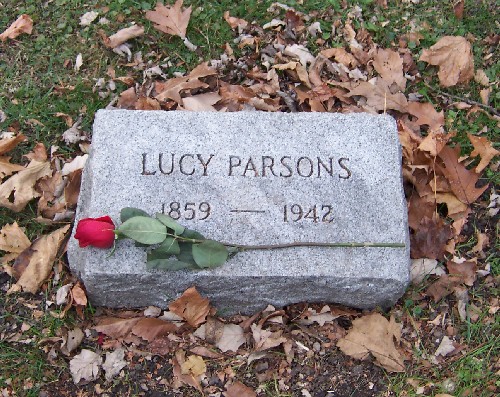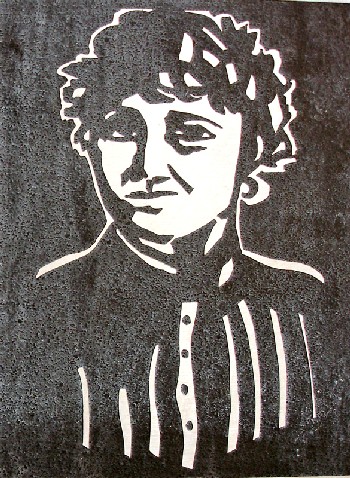Allegro
Remembering a Hero for Workers’ Rights
Labor History Month
Volume CVIII, No. 5May, 2008

|
We will remember! Labor history is often ignored or forgotten by mainstream media and school systems alike. In this essay, Marisa Friedman takes us on a journey to explore the life of Lucy Parsons, an inspirational activist and important figure in the history of workers’ rights. In addition to serving as Local 802’s theatre rep, Freidman is a Ph.D student at Stony Brook University. Her areas of concentration are organizations, political and economic sociology, and labor movements.
Lucy Gonzales Parsons, a Mexican and African American woman, was one of America’s most tireless labor activists. During her roughly 70-year career, her social and political beliefs underwent numerous transformations — from militant anarchism to communism. She never wavered from her life’s passion, taking on the plight of the oppressed and marginalized peoples of America, including workers, women, immigrants, and African Americans. Despite her long life, activism and influence, she has been all but written out of history. The destruction and theft of her papers makes telling her story an even more daunting, yet compelling task.
Lucy Gonzales was born in Texas in 1853. While her origins are unclear, there is evidence to suggest she may have been born a slave. Lucy, however, claimed to be of Mexican and Creek Indian ancestry. Identifying as Mexican and Indian, Lucy consistently denied her African American heritage. She used the surname Gonzales, insisting that her dark skin was because of her Mexican heritage. Around 1870 she met Albert Parsons, a former Confederate soldier who became a radical Republican after the Civil War. The two claim to have married in 1871, but no marriage certificate exists. It is likely that the two were never formally married because of miscegenation laws. The couple left Texas and settled in Chicago in 1873, where their careers as labor activists and revolutionaries began.
Life in Chicago, as well as in other industrial cities in America, was harsh because of an economic depression in which millions were left hungry and looking for work. As immigration increased, there became an oversupply of unskilled cheap labor. As the economic and social conditions deteriorated, workers were becoming increasingly radical and embraced socialist and anarchist ideology. The railroad strike in the summer of 1877 was one of the largest mass strikes in the 19th century. Lucy’s husband, Albert, addressing crowds of up to 25,000 workers, advocated peaceful ways of resolving the conflict. The railroad strike brought both Lucy and her husband into the vanguard of the various radical movements in Chicago. After being blacklisted from Chicago newspapers for his involvement in the railroad strike, Lucy opened a dress shop to support the couple. During this time, Lucy’s first writings in various socialist papers appeared, and she joined the Knights of Labor in 1881.

|
On May 4th, 1886, several people were killed during a confrontation in Haymarket Square. Eight anarchists, including Albert Parsons, were arrested and charged with conspiracy to murder. During this period, Lucy was under constant surveillance by the police. The authorities thought Lucy was just as dangerous and responsible for the bombings as her husband, but she was never charged. The government believed that no jury would convict a woman of murder and sentence her to death. Seven of the eight were sentenced to death, but only four, including Albert, were hanged, on Nov. 11, 1887.
By 1890, increased industrialization and new technology were changing the structure of the workplace. Craft unions, such as the American Federation of Labor, were having some degree of difficulty effectively mobilizing the masses of largely unskilled immigrant labor. A series of defeated strikes in the early 1890’s, such as the Homestead Strike, the silver miners’ strike in Coeur d’Alene in 1892, and the 1894 Pullman strike, convinced Parsons of the necessity of industrial, rather than craft-based, unionism.
In June 27, 1905, over 200 union delegates, including Lucy Parsons, met in a crowded and stuffy Chicago building to form what would be later called the Industrial Workers of the World. It was truly a wide assortment of delegates, including anarchists, socialists, craft unionists, and industrial unionists. The founding convention was contentious, as all of the factions represented disagreed over some basic issues. Some believed in combining political with economic action, while others adamantly opposed linking a union to any political party. There was disagreement over how best to divide workers along industrial lines. The one point, however, that unified the delegates, and was indeed the primary reason for the convention, was their belief that the American Federation of Labor (AFL) had failed the working class. The delegates in Chicago had one main goal, to create a new rival union that would remedy the perceived failures of the AFL.
Parsons began publishing the Liberator newspaper under the IWW label in 1905. She wrote numerous articles for the paper, including attacks on the AFL, a series on labor history, and a few pieces advocating birth control. While a staunch advocate of industrial unionism, Parsons left the organization in 1912 and helped found the Syndicalist League of North America with William Z. Foster.
The start of World War I created an economic depression as factories closed for, among other things, a decline in the European market for their goods. In the winter of 1915, Lucy Parsons helped organize a hunger demonstration outside Jane Addams’ Hull House. Police brutally attacked and arrested the peaceful protesters.
Twenty-seven years later on March 7th, 1942, a blind Lucy Parsons died in a house fire. She was 89 years old. For almost 70 years, she indefatigably fought for the rights of workers everywhere. Although she started her activism as an anarchist and died a communist, Lucy Parsons’ revolutionary beliefs remained unchanged.
